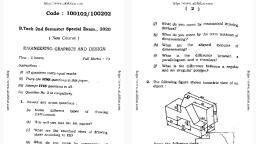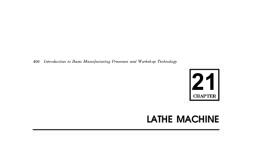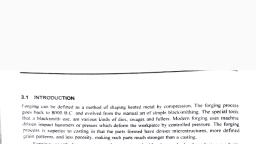Page 1 :
4.1 WIRE DRAWING, To manufacture long slender products (wire, tube), material is drawn through a die. The material is, deformed by compression, but the deformation force is supplied by pulling on the deformed end of, the wire or rod. This is termed 'indirect compression'. Most drawing is done cold., Wire drawing is an operation to produce wire of various sizes within certain specific tolerances., The process involves reducing the diameter of rods or wires by passing them through a series of, wire drawing dies with each successive die having smaller bore diameter than the one preceding it, (see Fig. 4.1). The drawing force must not exceed the strength of the drawn wire. Typically this, means that the maximum reduction (as area, not diameter) attainable is less than 50%. In practice, reduction is usually limited to 20-30% to avoid frequent breakage. The final wire size is reached as, the wire passes through the last die in the series., Direction of wire drawing, Wire drawing dies with, reducing bore diameter, Fig. 4.1. Wire drawing., A wire drawing die as shown in Fig. 4.2 is a tool that consist of a highly polished, shaped hole, through which wire is drawn to reduce its diameter. The choice of die material, viz. natural or synthetic, single crystal diamond, polycrystalline diamond, carbide etc. depends on the material of the wire to be, drawn and the operating parameters.
Page 2 :
Manufacturing Science-I, 54, Entry of wire, Cemented, tungsten carbide, support annulus, Shaper, hole, Polycrystalline, diamond, Exit of wire, Fig. 4.2. Wire drawing die., The difference between drawing and extrusion processes is that when the metal is forced through, the die by a tensile force applied to the metal at the exist of die it is called drawing, while when a, compressive force is applied at the entry of the die it is called extruding., 4.1.1 Defects in Wire Drawing, [UPTU: 2001-02, 2006-07], Defects occur in wire drawing because of ploughing by hard particles and local breakdown of the, lubricating film. Some common defects are :, • Bulge formation: This occurs in front of the die due to low reduction and high die angle., • Internal cracks (Centre burst or centre-cracking): The tendency of cracking increases with, increasing die angle, with decreasing reduction per pass, with friction and with the presence of, inclusions in the material. (See defects in extrusion)., • Seams : These appear as longitudinal scratches or folds in the material. Such defects can open, up during subsequent forming operations by upsetting, heading, thread rolling or bending of, the rod or wire., • Surface defects: Various types of surface defects can also result due to improper selection of, process parameters and lubrication., 4.1.2 Applications of Wire Drawing, Wire drawing is used for the manufacture of fine wires for electrical and electronic equipments, cables,, springs, musical instruments, fencing, bailing, wire baskets and shopping carts, etc.
Page 3 :
4.2 TUBE DRAWING, Tube drawing normally makes tubes to size from hollow 'tubeshells' produced by extrusion. They, are then cold drawn to size by a succession of passes, with interstage anneals as required and supplied, either in straight lengths or coil. Fig. 4.5 shows a typical tube drawing process with a floating plug., Starting, I.D., Starting, wall, Draw die, Finish, wall, Starting O.D., Floating plug, Finish O.D., Finish I.D., Fig. 4.5. Tube drawing., The common methods of tube drawing are : Tube sinking, Tube drawing with a plug or stationary, mandrel and Tube drawing with a moving mandrel., 1. Tube sinking [see Fig. 4.6] : This method is generally not preferred since no support is provided, on the inner surface of the tube and as a result wall thickness may slightly increase.
Page 4 :
Manufacturing Science-, 66, Draw die, Tube, Pull, Fig. 4.6. Tube sinking., 2. Tube drawing with a plug : In this method tubes of greater dimensional accuracy are obtained, because of the proper support provided both at the inner and outer surfaces of the tube. The pluo, used may be of cylindrical or conical shape and is of either fixed or floating type (see Fig. 4.7). In a, fixed plug, friction is more as compared to a floating plug. For the same reduction in area, the drawing, load will be less with floating plug than with a fixed plug., Draw die, Tube, Pull, Plug, (a) Fixed Plug., Draw die, Tube, Pull, Plug, (b) Floating Plug., Fig. 4.7. Tube drawing with a plug.
Page 5 :
Drawing and Extrusion Processes, 67, 3. Tube drawving with a moving mandrel (see Fig. 4.8) : This method is similar to that of a, plug drawing except the difference that in this case a movable mandrel is used. Because of the movable, mandrel, friction is minimized but the mandrel has to be removed by rolling, hence there is a slight, increase in the diameter of tube. This results in reduction of dimensional tolerances., Draw die, Tube, Pull, Moving, mandrel, Fig. 4.8. Tube drawing with a moving mandrel., 124Anahvein

























































































